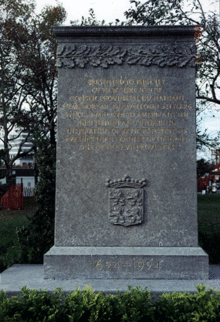Jessé de Forest
Jessé de Forest (1576 – October 22, 1624) was the leader of a group of Walloon Huguenots who fled Europe due to religious persecutions. They emigrated to the New World, where he planned to found New-Belgium.
Background
Jessé de Forest was born in Avesnes (County of Hainaut, now Nord, France). The family name originated from the village of Forest in the canton of Landrecies near Avesnes. (A Sports Illustrated article incorrectly claims[1] that Jessé was a son of the French king Henri IV.) Around 1609 he left Avesnes for Sedan and Montcornet before settling in Leiden, the Netherlands.
In Leiden, he moved to obtain the right to emigrate with his own and other Walloon families to the New World. During his stay, he also met Pilgrim Fathers, future passengers of the Mayflower. De Forest served with Prince Maurice of Nassau as a lieutenant and captain.[2]

On February 5, 1621, Jessé de Forest sent a round robin petition, to Dudley Carleton, 1st Viscount Dorchester, English ambassador to The Hague. It applied for permission to settle about fifty Walloon and French Huguenot families that planned to follow the Puritans to America (then called the West Indies) in Virginia. De Forest asked to dispose over a territory of eight English miles radius. Known as the Round Robin, this document is now preserved in the British Public Record Office. On August 11, 1621, the Virginia Company gave an agreement in principle, but raised some restrictions. The worse one was the refusal to have the settlers dwell together in one autonomous colony. De Forest declined this proposition.
New-Belgium
It was de Forest's desire to establish a Colony in the New World, so that the Walloons could practice their Reformed Protestant Christianity without persecution. He then sought permission from the Dutch to establish a colony in what is now New York City. He was granted permission. He assembled approximately 60 families of Walloons and Dutch Protestants for the settlement in New Amsterdam, New Netherland. The first permanent settlers would arrive in New Amsterdam during May 1624 (without de Forest).
The foundation of the Dutch West India Company in 1621 had given rise to multiple opportunities. In 1581, Philip II of Spain had prohibited commerce within his realm with Dutch ships, including in Brazil. Since the Dutch had invested large sums in financing sugar production in the Brazilian Northeast, a conflict began for control of the area. Proposing his services and those of his fellow countrymen to the Dutch West India Company, de Forest informed them that a group of families practicing various trades had the opportunity to emigrate to America. The States of The Netherlands, realizing the importance of such an opening for future colonization, immediately consulted the Directors of the Company, who were meeting in The Hague.
On August 27, 1622, after efforts delivered by Willem Usselincx and Jessé de Forest, the latter finally received the authorization to emigrate with other families to the West Indies. Left on reconnaissance for the coasts of Guyana in 1623, Jessé de Forest died on the Oyapock River bank (present borderline between Brazil and French Guyana), on October 22, 1624. His daughter Rachel (who married Jean de la Montagne, a high class New Amsterdamer) and his sons Isaac and Henri and other family members joined New-Belgium ten years later in the territories surrounding the future New York City.[3]
Legacy

There is a monument in the Battery Park section of lower Manhattan, New York City called the Walloon Settlers Memorial. That monument was given to the City of New York by the Belgian Province of Hainaut in honor of the inspiration of Jessé de Forest in founding New York City. Baron de Cartier de Marchienne, representing the government and Albert I, King of Belgium, presented the monument to Mayor John F. Hylan for the City of New York on May 18, 1924. There is also a monument in Jessé de Forest's honor in Avesnes, France, the College Jesse de Forest and Jesse de Forest Avenue.[4]
References
Other sources
- De Forest, John William The De Forests of Avesnes (and of New Netherland): A Huguenot thread in American colonial history, 1494 to the present time (New Haven, CT: The Tuttle, Morehouse & Taylor Co. 1900)
- De Forest, Emile Johnston A Waloon Family in America; Lockwood De Forest and His Forbears; in Two Volumes. Together with a Voyage to Guiana, Being the Journal of Jesse De Forest and His Colonists 1623-1625 (The Apple Manor Press. 2007, originally published in 1914)
- Griffis, William Elliot The Story of the Walloons at Home, in Lands of Exile and in America (Houghton Mifflin. 1923)
- Bayer, Henry G. The Belgians, First Settlers in New York and in the Middle States (Bowie, Md.: Heritage Books, 1987, c1925)
External links
- Walloon Settlers Monument. Battery Park
- Jesse de Forest Monument in Avesnes, France
- The Life of Jesse de Forest, the Petitioner for Freedom
- College Jesse de Forest
- Excerpt from Annual Bulletin No. 6 March 1985 from the Alumni Association of College and Primary School Boys Avesnes upper.
- A Walloon family in America
Category:People of New Netherland
|